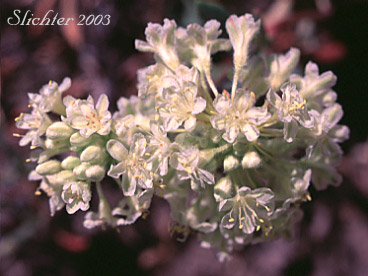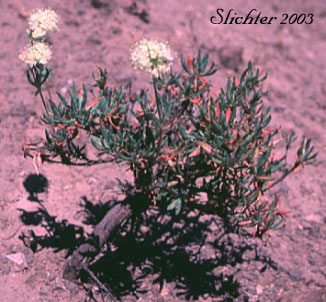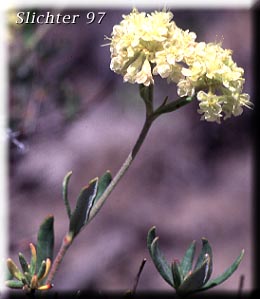The rock buckwheat is a large, shrubby perennial plant from 5-40 cm high. The leaves are oblanceolate to linear-spatulate or even linear and are found at the tips of the stems. The leaves are gray woolly below The leaves tend to be more woolly hairy below than above. Long flower stems are leafless except for a whorl of wide spatulate leaves directly at the point where the flower stem branches to give rise to the 2 or 3 round heads of flowers. Shorter flower stems may appear very leafy as it may be difficult to distinguish where the flower stem arises from the leafy stem. (See photos.)
The inflorescence often consists of two umbellate clusters of flowers at the tips of the stems. The involucres are bell-shaped to broadly tubular with 6-10 oblong lobes about 3 mm long and about equal in length to the tube. The flowers are yellow, often white or pinkish, in round clusters atop an umbel.
var. halimioides - Flowers pale yellow to cream or a faint dingy yellow. Inflorescence capitate or umbellate. Leaf blades usually narrowly oblanceolate to narrowly spatulate with non-revolute margins.
var. sphaerocephalum - Flowers bright yellow. Inflorescence umbellate to compound-umbellate. Leaf blades oblanceolate with non-revolute margins (not rolled under).
var. sublineare - Flowers pale yellow to cream or a faint dingy yellow. Inflorescence capitate or umbellate. Leaf blades usually linear-oblanceolate with revolute (rolled under) margins.
Similar Species:
Douglas' Buckwheat: Eriogonum douglasii - Similar to variety sublineare.
Piper's Buckwheat: Eriogonum flavum -
Wyeth Buckwheat: Eriogonum heracloides -
Sulfurflower: Eriogonum umbellatum -
Rockbuckwheat is found amongst sagebrush and juniper in the lowlands to the ponderosa forest at moderate elevations.
Rock buckwheat may be found from north-central Washington south along the east Cascade slope to northeastern California, and east to western Idaho and Nevada.


